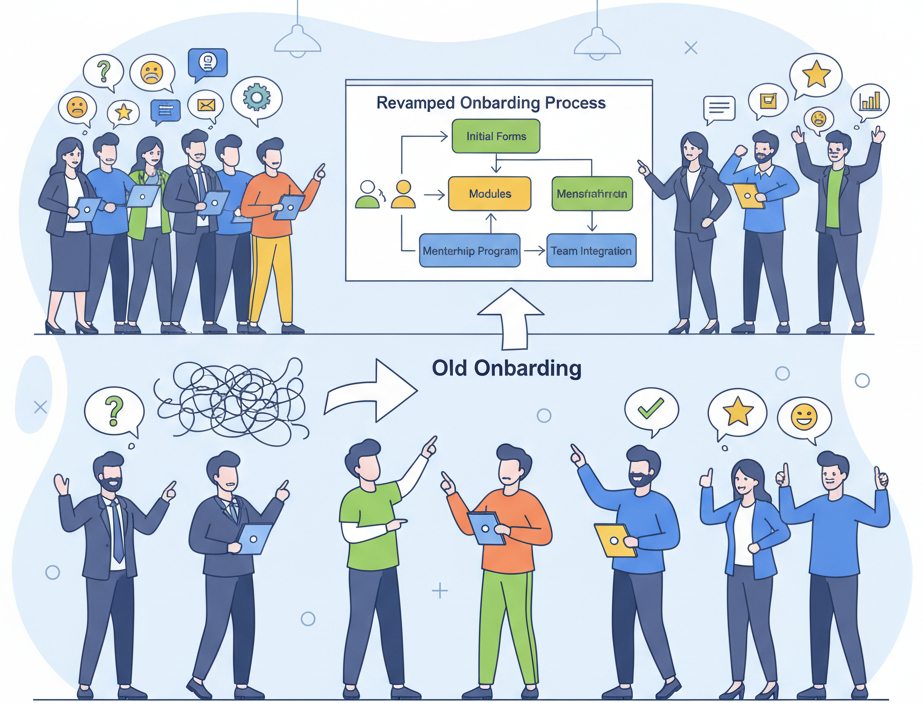Now Reading: Agile Affinity Mapping: Human Resources Case Study
-
01
Agile Affinity Mapping: Human Resources Case Study
Agile Affinity Mapping: Human Resources Case Study
How a Fortune 500 Company Revamped its Onboarding with Employee Feedback
An HR department analyzed feedback from 50 new hires to pinpoint systemic flaws in their onboarding process, leading to a data-driven initiative that reduced confusion, accelerated productivity, and increased new hire satisfaction.

The Challenge
The team had just completed 15 hour-long user interviews about the app’s bill payment feature. They were faced with over 200 pages of transcripts—a mountain of valuable but unstructured qualitative data. They needed a systematic way to identify patterns and actionable insights without getting lost in the details or letting personal biases influence the outcome.
The Process: From Chaos to Clarity
Before the Planner: Gathering Raw Data
The HR team collected anonymous feedback via a survey sent to all employees who had joined in the last six months. They carefully compiled all the open-ended responses to the question ‘Describe the biggest challenge you faced during your first 90 days’ into a central document, ensuring every voice was captured.
Step 1: Prepare for Affinity Mapping
Using the planner’s “Prepare” step, they set a clear, actionable objective: “Identify key friction points in the onboarding journey to create a data-backed Q3 improvement plan.” Recognizing the need for cross-functional buy-in, they gathered a team including HR business partners, an IT manager, and two department heads who frequently hired new employees.
Step 2: Conduct the Mapping Session
In the “Conduct” step, they planned a half-day, in-person workshop using physical sticky notes to encourage interaction. The plan was for each participant to silently read through the feedback and write individual issues on notes. These would then be posted on a large wall, and the group would work together to cluster them into emergent themes.
Step 3: Analyze and Prioritize Groups
The “Analyze and Prioritize” plan involved simple but effective dot voting. Once themes were established (e.g., “IT equipment delays,” “unclear role expectations,” “information overload”), each participant was given three dot stickers to vote on the themes they felt were most critical to solve. This democratic approach ensured the priorities reflected a group consensus.
Step 4: Implement and Monitor Actions
For “Implement and Monitor,” the plan was to create “Onboarding Improvement Tiger Teams” for the top 3 voted themes. These small, empowered groups would be responsible for proposing and piloting solutions. Success would be measured by a follow-up pulse survey, with a specific target of a “20% improvement in the onboarding satisfaction score.”
After the Planner: Running the Workshop
The generated report served as the blueprint for the workshop facilitator. The process of affinity mapping worked seamlessly, transforming a long document of complaints into a clear, visual map of the core issues. The dot voting unequivocally prioritized IT setup delays, lack of a clear 30-60-90 day plan, and inconsistent mentorship as the top three problems. The Tiger Teams were formed on the spot, with clear mandates based on the workshop’s tangible output.
The Results
The structured approach of the Affinity Mapping Planner allowed the HR team to move beyond anecdotes and pinpoint systemic issues with broad consensus. This created a clear, actionable path for improvement and secured the necessary executive support to enact real change.
- Secured executive buy-in for a significant onboarding budget increase by presenting a data-driven case based on the findings.
- Launched a revamped, standardized onboarding program that resulted in a 30% increase in new hire satisfaction scores.
- Reduced average IT setup time for new employees from 3 days to just 1 day, allowing them to be productive sooner.
- Improved manager satisfaction with the onboarding process, as they now had a clear framework to follow.

